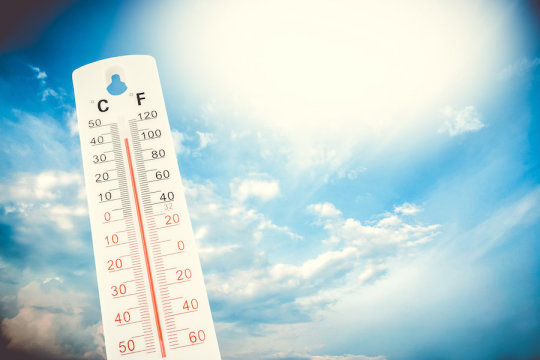[ad_1]
While extreme cold and snow often make headlines in the Northeast, by 2060, there will be far more record heat. Imagine the most sweltering day of the year. By 2060, you will experience that type of hot day for approximately three weeks of the year, assuming we don’t substantially reduce greenhouse gas emissions. According to a Dartmouth study, of the rural Northeast counties represented, those in the bottom two lowest income quartiles will be hit hardest, as their communities will be disproportionately affected by increases in extremely hot days relative to wealthier counties. The findings are published in the Annals of the American Association of Geographers.
Previous studies on climate change in the Northeast have often focused on urban impacts along the Eastern seaboard, but this is the first to examine future climate impacts in rural areas, including how changes in temperature and precipitation extremes may affect counties that are more vulnerable with respect to median income and population. Rural areas feature unique challenges due to their physical isolation, natural resource dependent economics and high poverty rates.
“Our projections suggest that climate change adaptation strategies in the rural Northeast should emphasize developing resilience to heat waves, such as increasing access to public spaces with air conditioning and improving health care responses to emergencies initiated or exacerbated by heat. This is especially important for counties in the lowest income quartile, who will be especially vulnerable to extreme heat events due in part to their growing populations,” explains lead author Jonathan Winter, an assistant professor of geography and principal investigator of the Applied Hydroclimatology Group at Dartmouth.
The study looks at rural counties in the Northeast from Maine to West Virginia with populations of 250,000 or less. Counties with larger populations, many of which have been studied in other climate change work, were excluded and masked out as urban areas. The research team compared historical data (1976-2005) to future climate scenarios (2046-2075) and examined the hottest and coldest days of the year (daily highest annual maximum and lowest annual minimum temperatures, statistically), the day with the most precipitation, and the two-week period with the least precipitation in low and high greenhouse gas emissions scenarios using four global climate model simulations. Data was obtained from the U.S. Environmental Protection Agency, U.S. Census Bureau, NOAA’s National Centers for Environmental Information, and World Climate Research Programme’s Working Group on Coupled Modelling.
For the analysis, the researchers used greenhouse gas emissions scenarios known as representative concentration pathways (RCPs), which provide trajectories on future emissions and are used extensively in the study of climate change. While there are four RCPs (from low to high, RCP 2.6, RCP 4.5, RCP 6 and RCP 8.5), the study focused on lower and high greenhouse gas emissions scenarios of RCP 4.5 and RCP 8.5. The U.S. is currently on the path of RCP 8.5. Known as the business as usual scenario, RCP 8.5 is the worst-case scenario of the four, as it assumes emissions will continue to be high with minimal efforts to mitigate emissions.
The research team was especially interested in daily extreme heat and daily extreme cold events — the hottest temperature and coldest temperature of the year, statistically. According to the study, vulnerable counties (in the bottom two income quartiles) in the Northeast will experience the coldest temperature of the year for 1976-2005 23 times per year by 2046-2075 for the high greenhouse gas emissions scenario, and 11 times per year for the lower emissions scenario. “In other words, by the middle of this century, every year counties with the lowest income in the Northeast will experience more than two decades worth of our current hottest day. Our findings agree with other climate change studies that have found increasing heat extremes and higher maximum daily temperatures across this region in the future,” says Winter. Consistent with the increase in daily extreme heat events in both scenarios, the incidence of daily extreme cold events — days with the coldest temperature of the year for 1976-2005, decreases to one in five years for the high greenhouse gas emissions scenario and to one in four years for the lower emissions scenario.
In addition to the Northeast’s increase in daily heat events, daily extreme precipitation — the rainiest days of the year for 1976-2005, is expected to increase by 15 percent and 20 percent for the high and lower greenhouse gas emissions scenarios, respectively.
According to the study’s projections, by 2060, the overall population in the rural Northeast will decline by 9 percent while the most vulnerable (bottom quartile median income) county populations grow by 30 percent. This is striking given that most counties are expected to experience population declines.
To prepare for extreme heat events, local and state governments in the rural Northeast may want to consider redirecting public resources from heating to cooling measures in the future.
The study builds on earlier research led by Winter, who has examined the causes of more extreme precipitation in the Northeast.
Story Source:
Materials provided by Dartmouth College. Note: Content may be edited for style and length.
[ad_2]















